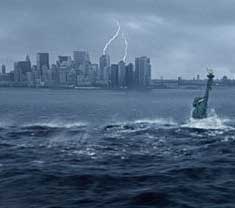There’s been a huge spike in the increase of atmospheric CO2 levels in the past two years, The Guardian reports. This is quite bad on its own, but it’s really terrible if it represents what theoreticians believe it may.
Earth has several carbon sink processes, or ways that excess CO2 can be sequestered. The most obvious, and most important, is in plant matter, since plants, of course, convert CO2 into oxygen. The trouble is that global warming decreases the ability of plants to absorb CO2, and, as every schoolchild knows, deforestation is rampant. The rainforests of Central and South America have been reduced in size tremendously, which could be problematic, because these rainforests have long served as, essentially, the planet’s lungs. Inhalation of pollutants (such as cigarette smoke) reduces human lung capacity, and it’s little different globally.
So far, the change has been gradual. The planet has slowly been getting hotter, the ice caps have been melting slowly, the atmosphere has slowly been getting more polluted.  The real fear, as envisioned in this year’s over-the-top The Day After Tomorrow, is that we will hit the tipping point, the moment when gradual change gives way to sudden, catastrophic change. In seismology, this is when the gradually slipping of a pair of tectonic plates creates more pressure than a chunk of plate can handle, and the two suddenly slide past each other by a few feet in 5-10 seconds. This yields an earthquake.
The real fear, as envisioned in this year’s over-the-top The Day After Tomorrow, is that we will hit the tipping point, the moment when gradual change gives way to sudden, catastrophic change. In seismology, this is when the gradually slipping of a pair of tectonic plates creates more pressure than a chunk of plate can handle, and the two suddenly slide past each other by a few feet in 5-10 seconds. This yields an earthquake.
Should the gradual absorption of CO2 by our ever-dwindling greenery suddenly become unable to absorb our ever-increasing levels of atmospheric carbon dioxide, we would have what could be thought of as a climatequake. Whatever that would entail — and researchers really aren’t sure — it may make The Day After Tomorrow look a little less over-the-top.